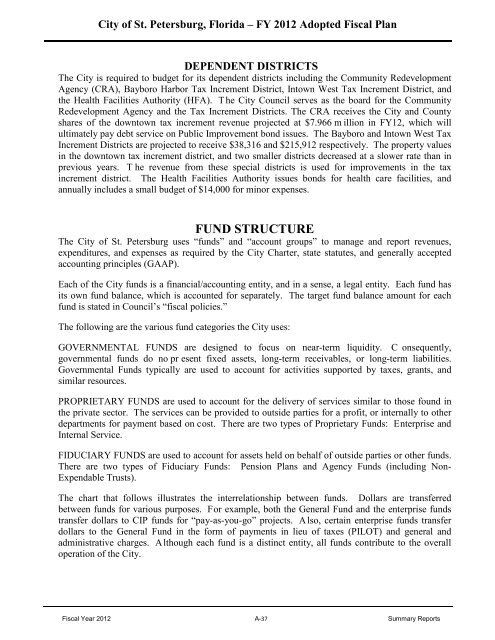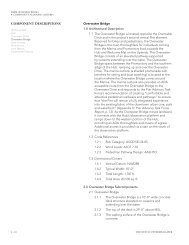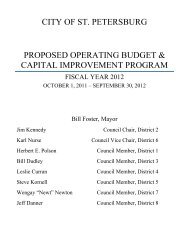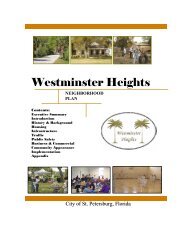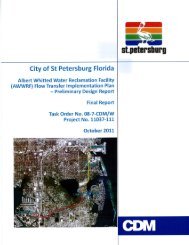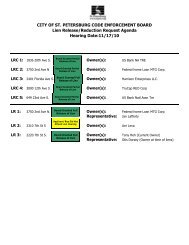- Page 1 and 2: CITY OF ST. PETERSBURG FLORIDA Adop
- Page 3 and 4: CITY OF ST. PETERSBURG OPERATING BU
- Page 5 and 6: USING THIS ONLINE VERSION: THROUGHO
- Page 7 and 8: City of St. Petersburg, Florida- FY
- Page 9 and 10: City of St. Petersburg, Florida- FY
- Page 11 and 12: Section A EXECUTIVE SUMMARY
- Page 13 and 14: City of St. Petersburg, Florida - F
- Page 15 and 16: City of St. Petersburg, Florida - F
- Page 17 and 18: City of St. Petersburg, Florida - F
- Page 19 and 20: City of St. Petersburg, Florida - F
- Page 21 and 22: City of St. Petersburg, Florida - F
- Page 23 and 24: City of St. Petersburg, Florida - F
- Page 25 and 26: City of St. Petersburg, Florida - F
- Page 27 and 28: City of St. Petersburg, Florida - F
- Page 29 and 30: City of St. Petersburg, Florida - F
- Page 31 and 32: City of St. Petersburg, Florida - F
- Page 33 and 34: City of St. Petersburg, Florida - F
- Page 35 and 36: City of St. Petersburg, Florida - F
- Page 37 and 38: City of St. Petersburg, Florida - F
- Page 39 and 40: City of St. Petersburg, Florida - F
- Page 41 and 42: City of St. Petersburg, Florida - F
- Page 43 and 44: City of St. Petersburg, Florida - F
- Page 45 and 46: City of St. Petersburg, Florida - F
- Page 47: City of St. Petersburg, Florida - F
- Page 51 and 52: City of St. Petersburg, Florida - F
- Page 53 and 54: City of St. Petersburg, Florida - F
- Page 55 and 56: Section B FISCAL POLICIES
- Page 57 and 58: City of St. Petersburg, Florida - F
- Page 59 and 60: City of St. Petersburg, Florida - F
- Page 61 and 62: City of St. Petersburg, Florida - F
- Page 63 and 64: City of St. Petersburg, Florida - F
- Page 65 and 66: City of St. Petersburg, Florida - F
- Page 67 and 68: City of St. Petersburg, Florida - F
- Page 69 and 70: City of St. Petersburg, Florida - F
- Page 71 and 72: City of St. Petersburg, Florida - F
- Page 73 and 74: City of St. Petersburg, Florida - F
- Page 75 and 76: City of St. Petersburg, Florida - F
- Page 77 and 78: Section D REVENUE HIGHLIGHTS
- Page 79 and 80: City of St. Petersburg, Florida - F
- Page 81 and 82: Utility Taxes: City of St. Petersbu
- Page 83 and 84: City of St. Petersburg, Florida - F
- Page 85 and 86: City of St. Petersburg, Florida - F
- Page 87 and 88: City of St. Petersburg, Florida - F
- Page 89 and 90: City of St. Petersburg, Florida - F
- Page 91 and 92: City of St. Petersburg, Florida - F
- Page 93 and 94: City of St. Petersburg, Florida - F
- Page 95 and 96: City of St. Petersburg, Florida - F
- Page 97 and 98: City of St. Petersburg, Florida - F
- Page 99 and 100:
City of St. Petersburg, Florida - F
- Page 101 and 102:
City of St. Petersburg, Florida - F
- Page 103 and 104:
City of St. Petersburg, Florida - F
- Page 105 and 106:
City of St. Petersburg, Florida - F
- Page 107 and 108:
City of St. Petersburg, Florida - F
- Page 109 and 110:
City of St. Petersburg, Florida - F
- Page 111 and 112:
City of St. Petersburg, Florida - F
- Page 113 and 114:
City of St. Petersburg, Florida - F
- Page 115 and 116:
City of St. Petersburg, Florida - F
- Page 117 and 118:
City of St. Petersburg, Florida - F
- Page 119 and 120:
City of St. Petersburg, Florida - F
- Page 121 and 122:
City of St. Petersburg, Florida - F
- Page 123 and 124:
City of St. Petersburg, Florida - F
- Page 125 and 126:
City of St. Petersburg, Florida - F
- Page 127 and 128:
City of St. Petersburg, Florida - F
- Page 129 and 130:
City of St. Petersburg, Florida - F
- Page 131 and 132:
City of St. Petersburg, Florida - F
- Page 133 and 134:
City of St. Petersburg, Florida - F
- Page 135 and 136:
City of St. Petersburg, Florida - F
- Page 137 and 138:
City of St. Petersburg, Florida - F
- Page 139 and 140:
City of St. Petersburg, Florida - F
- Page 141 and 142:
City of St. Petersburg, Florida - F
- Page 143 and 144:
City of St. Petersburg, Florida - F
- Page 145 and 146:
City of St. Petersburg, Florida - F
- Page 147 and 148:
City of St. Petersburg, Florida - F
- Page 149 and 150:
City of St. Petersburg, Florida - F
- Page 151 and 152:
City of St. Petersburg, Florida - F
- Page 153 and 154:
City of St. Petersburg, Florida - F
- Page 155 and 156:
City of St. Petersburg, Florida - F
- Page 157 and 158:
City of St. Petersburg, Florida - F
- Page 159 and 160:
City of St. Petersburg, Florida - F
- Page 161 and 162:
City of St. Petersburg, Florida - F
- Page 163 and 164:
City of St. Petersburg, Florida - F
- Page 165 and 166:
City of St. Petersburg, Florida - F
- Page 167 and 168:
City of St. Petersburg, Florida - F
- Page 169 and 170:
Section F DEBT SERVICE
- Page 171 and 172:
City of St. Petersburg, Florida - F
- Page 173 and 174:
Section G CITY DEVELOPMENT
- Page 175 and 176:
City of St. Petersburg, Florida - F
- Page 177 and 178:
City of St. Petersburg, Florida - F
- Page 179 and 180:
City of St. Petersburg, Florida - F
- Page 181 and 182:
City of St. Petersburg, Florida - F
- Page 183 and 184:
City of St. Petersburg, Florida - F
- Page 185 and 186:
City of St. Petersburg, Florida - F
- Page 187 and 188:
City of St. Petersburg, Florida - F
- Page 189 and 190:
Department Mission Statement City o
- Page 191 and 192:
City of St. Petersburg, Florida - F
- Page 193 and 194:
Department Mission Statement City o
- Page 195 and 196:
Department Mission Statement City o
- Page 197 and 198:
Section H GENERAL GOVERNMENT
- Page 199 and 200:
City of St. Petersburg, Florida - F
- Page 201 and 202:
City of St. Petersburg, Florida - F
- Page 203 and 204:
City of St. Petersburg, Florida - F
- Page 205 and 206:
Department Mission Statement City o
- Page 207 and 208:
Department Mission Statement City o
- Page 209 and 210:
Department Mission Statement City o
- Page 211 and 212:
Department Mission Statement City o
- Page 213 and 214:
City of St. Petersburg, Florida - F
- Page 215 and 216:
City of St. Petersburg, Florida - F
- Page 217 and 218:
City of St. Petersburg, Florida - F
- Page 219 and 220:
City of St. Petersburg, Florida - F
- Page 221 and 222:
City of St. Petersburg, Florida - F
- Page 223 and 224:
City of St. Petersburg, Florida - F
- Page 225 and 226:
City of St. Petersburg, Florida - F
- Page 227 and 228:
City of St. Petersburg, Florida - F
- Page 229 and 230:
City of St. Petersburg, Florida - F
- Page 231 and 232:
City of St. Petersburg, Florida - F
- Page 233 and 234:
City of St. Petersburg, Florida - F
- Page 235 and 236:
City of St. Petersburg, Florida - F
- Page 237 and 238:
City of St. Petersburg, Florida - F
- Page 239 and 240:
City of St. Petersburg, Florida - F
- Page 241 and 242:
City of St. Petersburg, Florida - F
- Page 243 and 244:
City of St. Petersburg, Florida - F
- Page 245 and 246:
City of St. Petersburg, Florida - F
- Page 247 and 248:
City of St. Petersburg, Florida - F
- Page 249 and 250:
City of St. Petersburg, Florida - F
- Page 251 and 252:
City of St. Petersburg, Florida - F
- Page 253 and 254:
Section J PUBLIC SAFETY
- Page 255 and 256:
City of St. Petersburg, Florida - F
- Page 257 and 258:
City of St. Petersburg, Florida - F
- Page 259 and 260:
City of St. Petersburg, Florida - F
- Page 261 and 262:
City of St. Petersburg, Florida - F
- Page 263 and 264:
City of St. Petersburg, Florida - F
- Page 265 and 266:
Section K PUBLIC WORKS
- Page 267 and 268:
City of St. Petersburg, Florida - F
- Page 269 and 270:
City of St. Petersburg, Florida - F
- Page 271 and 272:
City of St. Petersburg, Florida - F
- Page 273 and 274:
Department Mission Statement City o
- Page 275 and 276:
Department Mission Statement City o
- Page 277 and 278:
City of St. Petersburg, Florida - F
- Page 279 and 280:
Department Mission Statement City o
- Page 281 and 282:
Objective and Performance Measure C
- Page 283 and 284:
City of St. Petersburg, Florida - F
- Page 285 and 286:
City of St. Petersburg, Florida - F
- Page 287 and 288:
City of St. Petersburg, Florida - F
- Page 289 and 290:
Section L Capital Improvement Progr
- Page 291 and 292:
City of St. Petersburg, Florida - F
- Page 293 and 294:
Section M Capital Improvement Progr
- Page 295 and 296:
City of St. Petersburg, Florida - F
- Page 297 and 298:
City of St. Petersburg, Florida - F
- Page 299 and 300:
City of St. Petersburg, Florida - F
- Page 301 and 302:
City of St. Petersburg, Florida - F
- Page 303 and 304:
City of St. Petersburg, Florida - F
- Page 305 and 306:
City of St. Petersburg, Florida - F
- Page 307 and 308:
City of St. Petersburg, Florida - F
- Page 309 and 310:
City of St. Petersburg, Florida - F
- Page 311 and 312:
City of St. Petersburg, Florida - F
- Page 313 and 314:
City of St. Petersburg, Florida - F
- Page 315 and 316:
City of St. Petersburg, Florida - F
- Page 317 and 318:
City of St. Petersburg, Florida - F
- Page 319 and 320:
City of St. Petersburg, Florida - F
- Page 321 and 322:
Project Descriptions City of St. Pe
- Page 323 and 324:
City of St. Petersburg, Florida - F
- Page 325 and 326:
City of St. Petersburg, Florida - F
- Page 327 and 328:
City of St. Petersburg, Florida - F
- Page 329 and 330:
City of St. Petersburg, Florida - F
- Page 331 and 332:
City of St. Petersburg, Florida - F
- Page 333 and 334:
City of St. Petersburg, Florida - F
- Page 335 and 336:
City of St. Petersburg, Florida - F
- Page 337 and 338:
City of St. Petersburg, Florida - F
- Page 339 and 340:
City of St. Petersburg, Florida - F
- Page 341 and 342:
City of St. Petersburg, Florida - F
- Page 343 and 344:
City of St. Petersburg, Florida - F
- Page 345 and 346:
City of St. Petersburg, Florida - F
- Page 347 and 348:
City of St. Petersburg, Florida - F
- Page 349 and 350:
City of St. Petersburg, Florida - F
- Page 351 and 352:
City of St. Petersburg, Florida - F
- Page 353 and 354:
Section Q Capital Improvement Progr
- Page 355 and 356:
City of St. Petersburg, Florida - F
- Page 357 and 358:
City of St. Petersburg, Florida - F
- Page 359 and 360:
City of St. Petersburg, Florida - F
- Page 361:
APPENDICES
- Page 371 and 372:
City of St. Petersburg, Florida - F
- Page 373 and 374:
City of St. Petersburg, Florida - F
- Page 375 and 376:
City of St. Petersburg, Florida - F
- Page 377 and 378:
City of St. Petersburg, Florida- FY
- Page 379:
Look At What We Can Accomplish! ST.


